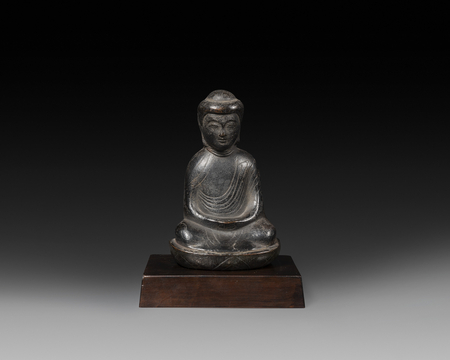Product Description
7785 A gilt-bronze repoussé figure of Amida Buddha (Amitābha) in jō-in(meditation mudra) seated on a lotus base, with a wood stand
Japan 14th/15th century Nambokucho-Muromachi Period
Dimensions: Figure H.16cm x W. 10cm x D. 5.5cm (6¼” x 4″ x 2¼”)
Wood stand H.3cm x W.13cm x D. 9cm (1¼” x 5¼ ” x 3 ¼”)
Provenance:
Collection Dr. Franz Haniel (1883-1965), then by decent via the family estate.
This figure was originally mounted as a Kakebotoke (hanging Buddha), which are generally circular votive plaques symbolising mirrors which represent the sacred body of kami (Shinto deities). They originate from the practice of Shinbutsu-shugo(syncretism of kami and buddhas) which was established in the Heian period. One of the few forms of Buddhist art unique to Japan, they can be found both at Shinto shrines and Buddhist temples and are presented as offerings to safeguard the compound and to ensure the prosperity of the Buddhist faith. In the Buddhist context they were hung from the eaves above the main entrance to an Image Hall, or above the frieze rail between the outer and inner sanctums of the shrine for the deity that protected the temple compound. They may also be used to represent hibutsu (hidden Buddha) which are not generally on show to the public.
For its simple formation as well as its wear consistent with age, the figure of Amida shows minimal features with simple incised lines. Yet the jō-in mudra, which is closely associated with the concept of complete absorption of thought, is evident. By intense contemplation of a single object of meditation, the bonds relating to the mental faculties and so-called ‘real phenomena’ are broken and the worshiper is thus enabled to identify himself with the Supreme Unity through a sort of super-intellectual status-raptus. In the jō-in, the position of the hands is that of the adepts of yogic contemplation. Thus, the jō-in symbolises specifically zenjō (ecstatic thought) for it is the gesture which indicates the suppression of all spiritual disquiet in order to arrive finally at the complete concentration on the truth.
The position of the hands in the mudra of concentration derives, in accordance with tradition, from the attitude which the historical Buddha assumed when he devoted himself to his final meditation under the Bodhi tree. This is the attitude he was found in when the demon armies of Mara attacked him. He was to alter it only when he called the earth to witness at the moment of his triumph over the demons. Consequently, the position symbolises specifically the supreme mediation of the historical Buddha but also the Buddhist qualities of tranquillity, impassivity and superiority.
Belief in Amida as Lord of the Western Paradise rose in popularity during the late 10th century. Based primarily on the concept of salvation through faith, it was not only a religion appealing to a broad range of people, but also a direct assertion of piety against the dogmatic and esoteric ritual of the more traditional Tendai and Shingon sects. In Amida’s Western Paradise the faithful are reborn, to progress through various stages of increasing awareness until finally achieving complete enlightenment.
Another factor that engendered faith in Amida was a widespread belief of the Three Periods of the Law known as the Days of the Dharma (the Buddhist teachings). This was an all-encompassing concept of society’s rise and fall that originated in Indian Buddhism and later became widespread in China and Japan. It foretold of the world’s ultimate decay and the complete disappearance of Buddhist practice. At the time, the Days of the Dharma in Japan were divided into three periods. The first phase, the Age of Shōbō, was said to last 1000 years after the death of the Buddha. It was believed to be a golden period during which followers had the capacity to understand the Dharma. The second phase, the Age of Zōhō, was also to last 1000 years, during which Buddhist practice would begin to weaken. The third and final phase lasting 3,000 years, the Age of Mappō, was when Buddhist faith would deteriorate and no longer be practiced. In Japan the Age of Mappō was said to begin in 1052 AD, and a sense of foreboding thus filled the land, with people from all classes yearning for salvation leading to a widespread practice of continuously repeating the mantra of Amida Buddha.
For examples of kakebotoke see:
Anne Nishimura Morse et. Al. eds., Object as Insight, Japanese Buddhist Art and Ritual, Katonah Museum of Art, p. 46-47, pl. 9/10.
Nara National Museum, Bronze Sculpture of the Heian & Kamakura Periods (Special Exhibition), (Kyoto, 1976), p. 49-53
For more about kakebotoke and further examples, see Naniwada Toru, Nihon no bijutsu (Art of Japan), No. 284 Kyozo to Kakebotoke (Votive Buddhist mirrors and plaques), (Tokyo, 1990).








